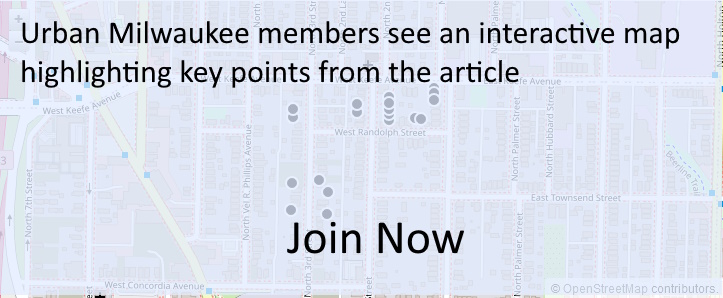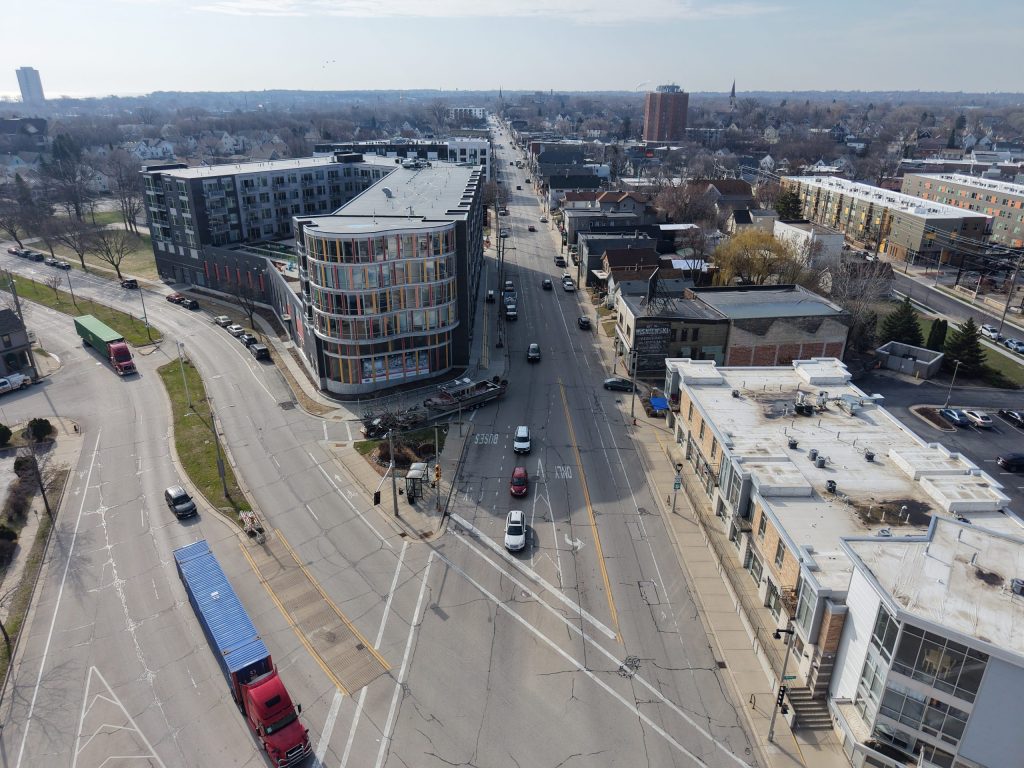Three-Way Standoff on Workforce Housing in Milwaukee
Council, administration, developers seek solution between low-income and luxury.
What a mess.
With rising construction costs and elevated interest rates, everyone at Milwaukee City Hall seems to agree that some amount of subsidy is necessary to create a supply of new affordable and workforce housing. But the how and when are proving to be elusive.
The issue came to a head Tuesday during a Zoning, Neighborhoods & Development Committee meeting in an unusual three-way debate that featured the administration, council and a developer all making their case publicly.
Two resolutions request the Department of City Development(DCD) finalize amendments to two Walker’s Point tax incremental financing (TIF) districts. But the resolutions, as they appear in the city’s legislative records system, are only titles.
“These amendments do not exist,” said DCD Commissioner Lafayette Crump.
Crump questioned if the resolutions were appropriate, given that they were introduced last Friday, a fact later attributed to a clerical error, and they they direct DCD to use TIF, something state law effectively reserves for Crump and the Redevelopment Authority he leads.
But that didn’t stop council members from venting their frustrations and making it clear what they expect to happen.
“These files represent a demand that some action be taken,” said Common Council President José G. Pérez, the sponsor. “Developers I’ve spoken with and I know talk about dealing with the question of TIF like asking a question of a Magic Eight Ball.”
“I hear from lots of individuals in the development community… that there does seem to be, in the words of Jimmy Carter, ‘a certain malaise’ in the Department of City Development with regard to TIF policy,” said new committee chair Ald. Robert Bauman.
Pérez wants the city to provide subsidies to New Land Enterprises to complete its long-proposed Via and Florida Street buildings. Both buildings are effectively clones of earlier New Land projects that provided new housing targeted at a mid-market price point. New Land managing director Tim Gokhman said construction costs are up 40% since 2020, but incomes and rental rates have not kept pace, forcing the company to pause the projects. The developments are now being labeled “workforce housing,” a price point between affordable housing and market-rate housing.
The city has provided subsidies for “affordable” housing more than 20 times said Crump, defining the term to be households with incomes below 60% of the county median income, or $61,000 for a family of four in 2024. The city subsidy, structured as a developer-financed TIF district where a developer fronts the capital and recoups the amount from incremental property tax revenue over a set period of years, closes a financing gap that other financing sources, often low-income housing tax credits, leave.
“The desire is to expand what we are doing,” said Crump. “We are always looking for opportunities to leverage additional projects to develop the city while being good stewards of public resources, ensuring that capacity is available citywide.”
Crump said the city is now looking at subsidies for “workforce” housing, where household income is between 60% and 100% of the area median income, up to $102,000 in 2024. He said DCD has observed a shortage of new housing that serves that market, which makes too much to qualify for traditional subsidized housing, but not enough to pay for new market-rate housing.
“It’s been some time that we’ve been talking about this,” said Crump. And that’s the council’s primary issue.
“How long should this process take?” asked Bauman, noting DCD has indicated it would move that way almost a year ago. “A lot of the developers I’m told are going to the suburbs. The development process is fundamentally based on action.”
Crump said every developer has a different issue. “Some have access to sufficient patient capital, others have more challenges,” he said. Some, Crump said, indicated they could comply with the city’s hiring requirements for receiving subsidies, while others are asking for concessions. Others have taken issue with the city’s developer-financed strategy that transfers the risk from the city to the developer.
Bauman said he didn’t think it was necessary to develop a single policy and instead DCD should go case by case. Pérez said he was optimistic the city would eventually find a standard formula, like it did for the successful riverwalk system.
The commissioner characterized Pérez’s resolutions as “incredibly premature.”
But Bauman asked Crump to take some action. He acknowledged the council didn’t have the power to compel Crump to do so, so it was trying to do so in a “friendly, positive way.”
“You’re right, you have the sole authority to initiate the tax incremental financing and if you don’t initiate it, we’re all dead in the water,” said the alderman.
Gokhman Breaks It Down
A public discussion about TIF policy was unusual enough, but including a developer in it was an added twist.
“This is the conversation that is playing out in every city across the country… it just hits Milwaukee harder,” said Gokhman, an analytically-minded developer who was able throw a number of figures at the committee Tuesday.
“Since 2020, New Land can no longer do the type of development it used to do,” said the developer.
He cited the company’s 2018 start on KinetiK, a large housing development in Bay View. Rents are under $2 per square foot, with units costing approximately $200,000 to build. Gokhman said it would cost $270,000 per unit to construct the same building today. “That’s the construction cost hit,” he said.
Nova, a building similar KinetiK but in East Town, started in 2021. “Our rents had to be 35% higher at Nova to meet the same level of investor return,” he said. And now costs have gone up more. An $1,800-per-month unit would now need to cost $2,100. “That’s why we are no longer building it, and that’s just the construction cost.”
The demand for the housing hasn’t gone away.
New Land’s existing portfolio of housing that it considers naturally occurring affordable housing (unsubsidized), approximately a quarter of its holdings, is 98% occupied. “Ninety-eight percent is great for us. It’s terrible for the market,” said the developer.
Gokhman also cited a 2024 Realtor.com report and Community Development Alliance data that shows 53% of city residents are cost-burdened (spend more than 30% of their income on rent), while metro area rents are hitting record highs. Milwaukee is now a Midwest leader in a contest that isn’t good to win.
New Land, which has spent 30 years focusing solely on the city, finds itself among the companies now looking to the suburbs for higher incomes and subsidies.
The company is developing projects in Green Bay and suburban Glendale, both with TIF subsidies. He said the Glendale agreement came together in 90 days. It’s taken 18 months on the Milwaukee projects said Gokhman.
“We spent 18 months talking about it, and during those 18 months we saw construction costs on those two projects go up more than $700,000,” he said.
Crump declined to discuss specifics publicly with the council.
But Crump, when asked by Ald. Russell W. Stamper, II, said “yes, it’s too long.”
“This is unacceptable commissioner. I just have to put that on the record. In order for us to be thriving, we have to keep the balling rolling,” said Ald. Mark Chambers, Jr.
“The answer could have been ‘no,’ the answer was ‘let’s try to figure this out,'” said Crump.
“I would rather hear ‘no’ than be dragged for 18 months,” said Gokhman. “We are banging our heads against a brick wall for a project that represents 10% of our development pipeline.” Last summer, Gokhman publicly pulled out of a request-for-proposal process for a downtown site for what he said was inaction.
He said the 2026 expiration of the federal Opportunity Zone program will further complicate things.
“If this project doesn’t move forward, it basically tells the development community that we’re not going to be able to get this done,” he said.
He said investors are seeking an estimated 7% yield on project costs, and that losing the Opportunity Zone tax advantage would only expand the financing gap.
“It’s a conversation that needs to be had, but it needs to be had with more than one developer,” said Alderwoman Milele A. Coggs.
Opportunities abound, including a plan to redevelop the 35-story 100 East office tower as housing and a lobbying push and legislative effort at the state level to unlock hundreds of millions of dollars set aside for housing that remains unspent.
Coggs also raised questions about what addressing workforce housing would do to affordable housing developers. Gokhman said the differences between development styles, including higher fees for affordable housing developers and capital access were likely to keep developers working in both areas.
“This has been an excellent TED Talk on real estate,” said Bauman. The entire discussion also spurred an impressive amount of “did you see that?” chatter among City Hall insiders.

Existing members must be signed in to see the interactive map. Sign in.
If you think stories like this are important, become a member of Urban Milwaukee and help support real, independent journalism. Plus you get some cool added benefits.
Political Contributions Tracker
Displaying political contributions between people mentioned in this story. Learn more.
- March 22, 2017 - Robert Bauman received $100 from Tim Gokhman
- May 20, 2016 - Robert Bauman received $100 from Tim Gokhman
- February 16, 2016 - Milele A. Coggs received $50 from Lafayette Crump
- February 12, 2016 - Robert Bauman received $100 from Tim Gokhman
- July 20, 2015 - Russell W. Stamper, II received $50 from Lafayette Crump
- March 27, 2015 - Robert Bauman received $100 from Tim Gokhman
- October 15, 2014 - Robert Bauman received $100 from Lafayette Crump
- September 8, 2014 - Robert Bauman received $100 from Lafayette Crump
City Hall
-
Committee Overturns Plan Commission, Recommends ‘Missing Middle’ Housing
 Apr 17th, 2025 by Jeramey Jannene
Apr 17th, 2025 by Jeramey Jannene
-
Council Committee Backs Return of Granny Flats
 Apr 16th, 2025 by Jeramey Jannene
Apr 16th, 2025 by Jeramey Jannene
-
Common Council Wants to Ban Hookah Sales to Those Under 21
 Apr 14th, 2025 by Evan Casey
Apr 14th, 2025 by Evan Casey




















“meet the same level of investor return” THIS is what’s killing housing and development across the entire country.
Investors will not be happy until all the orphans and puppies are smashed into a pulp and extract boiled down.
There is NEVER enough returns for these crooks. Decades of “line must go up” even after decades of contracting population, increasing income & wealth divide, etc is rearing its ugly head that “investors” and their insatiable greed are not sustainable.
It’s not that they just want returns, they want ever increasing and expanding returns. Just meeting last year’s number or lowering guidance during these turbulent times is unthinkable to the 10-1%.
Until Stakeholder Theory takes over the existing/prevalent thinking of the Friedman Doctrine, ALL investing across ALL segments and industries will continue to gasp for air and cry wolf.
Someone please tell Colin that pension funds – the ones representing teachers, firefighters, public employees and such – are the greedy investors he’s referencing. Pension funds represent 30 to 40% of all institutional real estate equity.
Maybe coupling folks’ pensions to real estate is just another peg of this core issue?